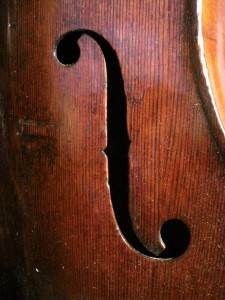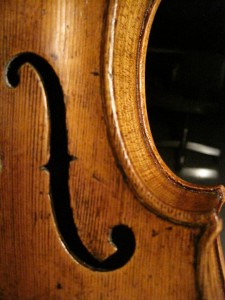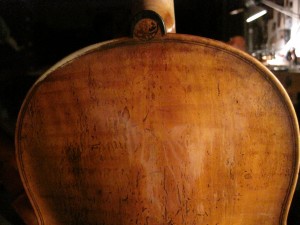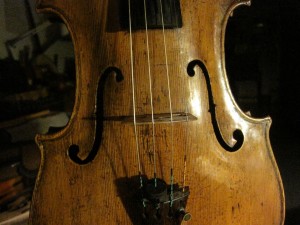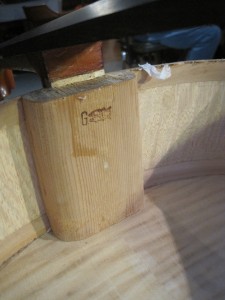
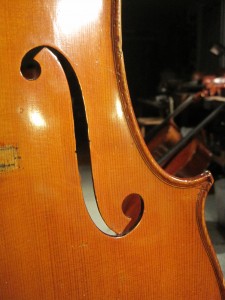
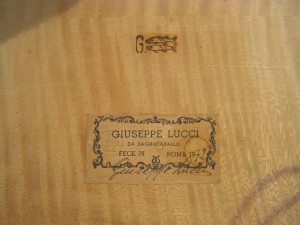 I am working on a fine cello by Giuseppe Lucci dated Roma 1972. With the top off we get a nice close-up view of his label and whimsical brand ( which refers to the “fishy” origin of his name). It was last sold through the Moennig shop to the distinguished cellist/teacher Metta Watts who has accepted the fact that she no longer needs such a fine cello. I worked on this cello many times during the years when I did all the cello work at the shop – though there was never time or the crying need to do all that could be done to make it look and sound at its very best. Now in my own shop I am able to change the bass bar and take care of all the other things inside -then, once the top is back on and I will be touching-up and restoring the”
I am working on a fine cello by Giuseppe Lucci dated Roma 1972. With the top off we get a nice close-up view of his label and whimsical brand ( which refers to the “fishy” origin of his name). It was last sold through the Moennig shop to the distinguished cellist/teacher Metta Watts who has accepted the fact that she no longer needs such a fine cello. I worked on this cello many times during the years when I did all the cello work at the shop – though there was never time or the crying need to do all that could be done to make it look and sound at its very best. Now in my own shop I am able to change the bass bar and take care of all the other things inside -then, once the top is back on and I will be touching-up and restoring the” lustrous light golden orange colored varnish” ( as justly stated on the Moennig paper). Its interesting to know an instrument for a long time and see the time is come for it to be in the hands of a player who can do justice to all its power and complexity.
lustrous light golden orange colored varnish” ( as justly stated on the Moennig paper). Its interesting to know an instrument for a long time and see the time is come for it to be in the hands of a player who can do justice to all its power and complexity.
Category Archives: Uncategorized
A family affair
Ricardo Morales (and Victoria) watch Amy Oshiro (wife & mother) play on her beautiful Telosphore Barbe c 1880 that they acquired from me. This Barbe was one of the principal workers in the Vuilluame workshop and it bears many similarities to the violins coming out of that great shop. Only later in his life did he make instruments that have his his label. Accompanying this violin is a great letter from the noted French maker Gustave Bazin stating this was the finest example of T Barbe’s work that he had ever seen.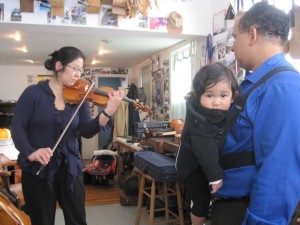 Amy tells me she uses the violin very often for her playing in the Philadelphia Orchestra where she feels it warmth and power projects beautifully…..and when Ricardo agrees too you know you have a good fiddle!
Amy tells me she uses the violin very often for her playing in the Philadelphia Orchestra where she feels it warmth and power projects beautifully…..and when Ricardo agrees too you know you have a good fiddle!
You might think Ricardo would be busy and immersed enough with his role as principal clarinet of the Philly O…..well you would be wrong. His boundless enthusiasm spills (or gushes) into the violin world – bringing an endless interest in instruments, character of sound, makers and just about everything else relating to string instruments.I think in a big way this is just an outgrowth of his lifetime of fussing over his clarinets – and that that endless search has now evolved into violins.
As he builds a collection of some of the finest new violins being made today its a pleasure to help him adjust, work on and admire along with him what these great things can do.
A fascinating coming together
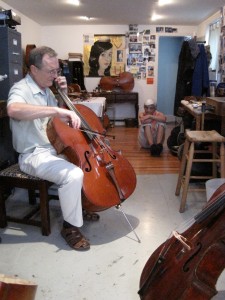 David Cole – son of Orlando Cole (and a distinguished cellist/teacher in his own right) is seen here playing a cello made by William Moennig Jr in 1939 which is a copy of his father’s celebrated Montagnana cello known as “The Sleeping Beauty” Sitting watching him play is Metta Watts , longtime assistant to Mr Cole and for decades the owner of this cello. It is now owned by a protege of hers who is an aspiring cellist. The cello happened to be in my shop for bushing (filling with wood) the old peg holes and reaming them out to fit new pegs.The Montagnana model is the broadest cello model whose small,stubby F-holes are swallowed up in the wide expanse of the breast area of the top
David Cole – son of Orlando Cole (and a distinguished cellist/teacher in his own right) is seen here playing a cello made by William Moennig Jr in 1939 which is a copy of his father’s celebrated Montagnana cello known as “The Sleeping Beauty” Sitting watching him play is Metta Watts , longtime assistant to Mr Cole and for decades the owner of this cello. It is now owned by a protege of hers who is an aspiring cellist. The cello happened to be in my shop for bushing (filling with wood) the old peg holes and reaming them out to fit new pegs.The Montagnana model is the broadest cello model whose small,stubby F-holes are swallowed up in the wide expanse of the breast area of the top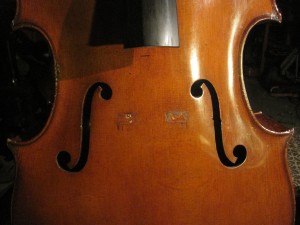
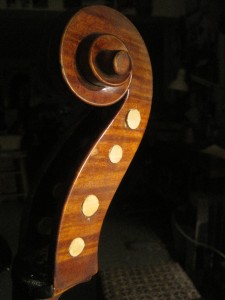
Latest bridge
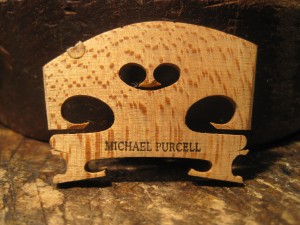
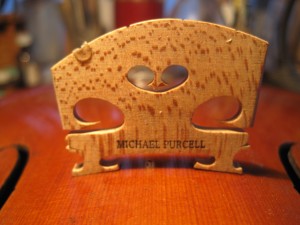 I’m finishing up this bridge for a very nice Antoniazzi violin. The bridge is a crucial part of the sound, playability and character of any string instrument and it demands the utmost skill for it to be all it should be. It first has to endure the immense string tension down and remain upright through it all. Its next purpose is to transfer the strings vibrations to the top as efficiently as possible. To perform both these roles effectively the bridge must have enough wood -with no extra to get in the way – and it must be in all in the right places. I think of it like an athlete – it must have all the muscle it needs and no fat. Lastly it must have style and personality which only comes from a sharp blade and a skilled hand. When all is done I hold my breath and brand it – hoping that I got my name on straight
I’m finishing up this bridge for a very nice Antoniazzi violin. The bridge is a crucial part of the sound, playability and character of any string instrument and it demands the utmost skill for it to be all it should be. It first has to endure the immense string tension down and remain upright through it all. Its next purpose is to transfer the strings vibrations to the top as efficiently as possible. To perform both these roles effectively the bridge must have enough wood -with no extra to get in the way – and it must be in all in the right places. I think of it like an athlete – it must have all the muscle it needs and no fat. Lastly it must have style and personality which only comes from a sharp blade and a skilled hand. When all is done I hold my breath and brand it – hoping that I got my name on straight
Bumpy ride on Southwest Airlines
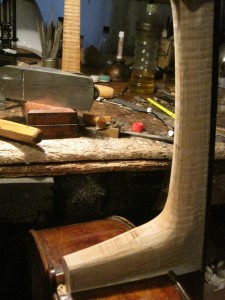
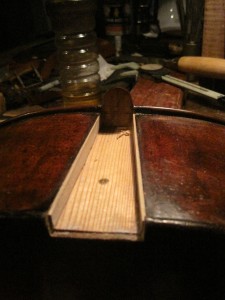
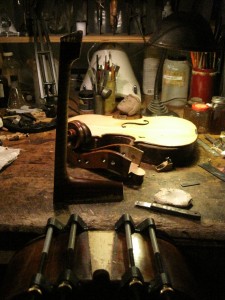 They may be good at moving people inexpensively, but they are certainly not to be trusted with fine musical instruments. This fine, early 19th century German cello was in a very sturdy shipping case when it must have been dealt a stunning blow. Luckily the damage was mostly confined to where the old neck graft joined the scroll. The new graft will carefully clean up all the ragged wood and restore the cello to its previous fine state and value. First the scroll needs to be cleaned up , with the sides of the pegbox flattened and prepared to accept the new neck. Next is the tricky job of getting the old neck out of the body. You carefully(!) make a saw cut just inside the button and work an opening knife along the joint where the neck stock joins the ribs. When you have loosened the neck all around you put clamps on the ribs adjacent to the neck – then the bold part of giving the neck a swift shot to one side. This will release the joint underneath the neck stock – but not without a dramatic (and heart stopping) thwack. This is the glue letting go of the joint between the end grain of the neck (which really is not a very strong joint) and the mortise of the top block. Now its time to prepare the mortise and fashion a new neck.
They may be good at moving people inexpensively, but they are certainly not to be trusted with fine musical instruments. This fine, early 19th century German cello was in a very sturdy shipping case when it must have been dealt a stunning blow. Luckily the damage was mostly confined to where the old neck graft joined the scroll. The new graft will carefully clean up all the ragged wood and restore the cello to its previous fine state and value. First the scroll needs to be cleaned up , with the sides of the pegbox flattened and prepared to accept the new neck. Next is the tricky job of getting the old neck out of the body. You carefully(!) make a saw cut just inside the button and work an opening knife along the joint where the neck stock joins the ribs. When you have loosened the neck all around you put clamps on the ribs adjacent to the neck – then the bold part of giving the neck a swift shot to one side. This will release the joint underneath the neck stock – but not without a dramatic (and heart stopping) thwack. This is the glue letting go of the joint between the end grain of the neck (which really is not a very strong joint) and the mortise of the top block. Now its time to prepare the mortise and fashion a new neck. 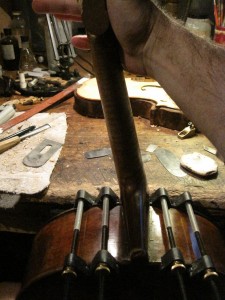
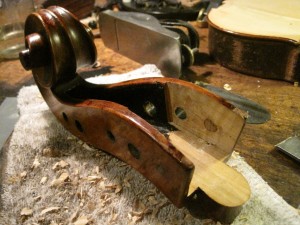
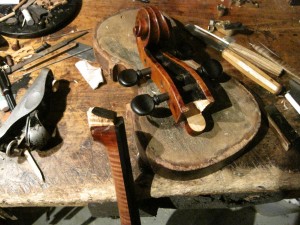
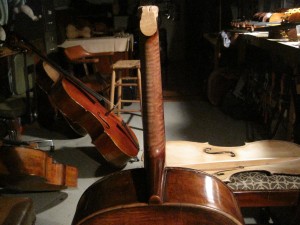
Beautiful 18th century Italian cello
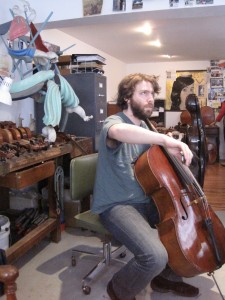

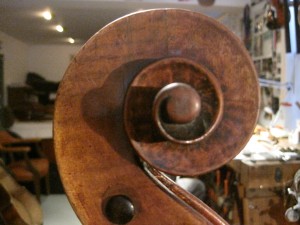
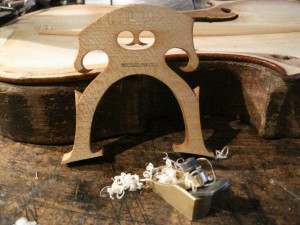 A beautiful cello owned by the famed Guildhall School in London was in my studio recently for some extensive gluing and a new bridge. We decided on a Belgian bridge for its ability to give a cello more punch and bold clarity of sound. With its higher legs and compressed torso the bridge gets to the height it needs to be with less wood than the traditional French bridge blank so there is less material in the way as the bridge transmits the sound from strings to body. The sculptor in me loves cutting these blanks with their graceful leg curves and jaunty, military bearing. The cello itself is a treat to behold with its rugged sculptural power, bold craftsmanship and subtle, artistic details. Bart Lafollette , the promising young cellist who has had the use of this cello treats me to a Bach suite while trying out the “new” cello – He claims it has never sounded better – high praise from him and the fact that the cello has spent time in the finest shops in London. Bart will be recording with the Doric Quartet in London and playing solo gigs in England and on the continent. Its great to be able to help him fill the hall with his great musicality.
A beautiful cello owned by the famed Guildhall School in London was in my studio recently for some extensive gluing and a new bridge. We decided on a Belgian bridge for its ability to give a cello more punch and bold clarity of sound. With its higher legs and compressed torso the bridge gets to the height it needs to be with less wood than the traditional French bridge blank so there is less material in the way as the bridge transmits the sound from strings to body. The sculptor in me loves cutting these blanks with their graceful leg curves and jaunty, military bearing. The cello itself is a treat to behold with its rugged sculptural power, bold craftsmanship and subtle, artistic details. Bart Lafollette , the promising young cellist who has had the use of this cello treats me to a Bach suite while trying out the “new” cello – He claims it has never sounded better – high praise from him and the fact that the cello has spent time in the finest shops in London. Bart will be recording with the Doric Quartet in London and playing solo gigs in England and on the continent. Its great to be able to help him fill the hall with his great musicality.
Neck Graft on J. B. Vuilluame cello
This fine cello sustained a fall where the neck sheared off. At this point in the process the old neck has been cut away ,the pegbox has been beveled to a flat thin edge and a new neck has been roughed out and glued into the pegbox.
At this point in the process the old neck has been cut away ,the pegbox has been beveled to a flat thin edge and a new neck has been roughed out and glued into the pegbox.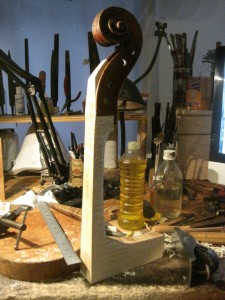 At this point I’ll begin to set the neck – and get it ready to play a piece by Dutilleux by a player in the Philadelphia Orchestra. One of the movements is just the cello section so it better be there!
At this point I’ll begin to set the neck – and get it ready to play a piece by Dutilleux by a player in the Philadelphia Orchestra. One of the movements is just the cello section so it better be there!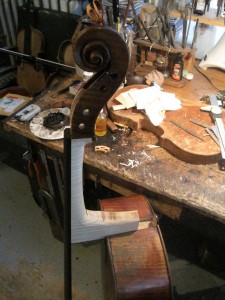
Richard Weichold Cello c. 1900
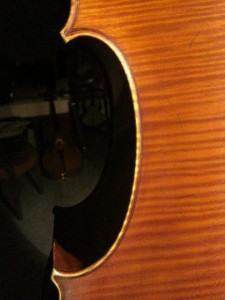
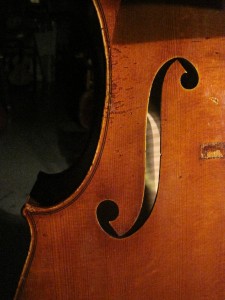 Richard Weichold was a bowmaker and violin dealer
Richard Weichold was a bowmaker and violin dealer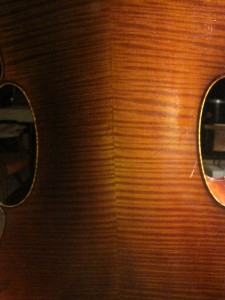 working in Dresden during the latter half of the 19th century.
working in Dresden during the latter half of the 19th century.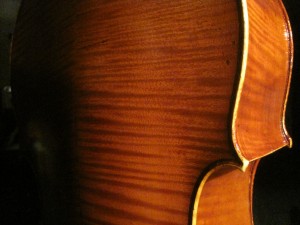 While probably not making this instrument himself, he obviously employed great makers and had them working up to a very high standard in this instance.This fine cello shows all he crisp, powerful beauty of “big city” German violin making at its best. The instrument is filled with strong,graceful details that show an aesthetic precision: from the delicately cut F-holes and outline
While probably not making this instrument himself, he obviously employed great makers and had them working up to a very high standard in this instance.This fine cello shows all he crisp, powerful beauty of “big city” German violin making at its best. The instrument is filled with strong,graceful details that show an aesthetic precision: from the delicately cut F-holes and outline to the care” to the artful resolution at the back of the scroll, to the great arching ,edge work and corners of the back. This finely modeled cello also has a deep red varnish of striking beauty.
to the care” to the artful resolution at the back of the scroll, to the great arching ,edge work and corners of the back. This finely modeled cello also has a deep red varnish of striking beauty. This cello is now in the hands of the talented young prodigy Bihn Park. He works it hard to get all he can and keeping it looking and sounding as beautiful as it can is a challenge, but well worth the effort to insure future players the opportunity to enjoy this wonderful cello
This cello is now in the hands of the talented young prodigy Bihn Park. He works it hard to get all he can and keeping it looking and sounding as beautiful as it can is a challenge, but well worth the effort to insure future players the opportunity to enjoy this wonderful cello
Antonio Cavalazzi 1935 Ravenna
 This beautiful, charming violin has come to me for ,among other things, a new fingerboard. It was made by a little known maker who was born in 1905, worked in Ravenna an
This beautiful, charming violin has come to me for ,among other things, a new fingerboard. It was made by a little known maker who was born in 1905, worked in Ravenna an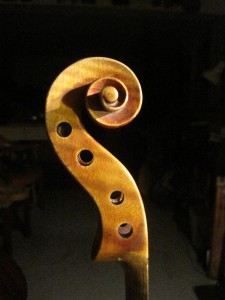 d was the pupil of the maker Domenico Veggi. There is so much to like about this fiddle. The bold S curve of the scroll. The artful, unfussy fluting of the lower tabs of the F-holes. The beautiful back with its lovely,soft, transparent orange varnish, handsome wood and stylish outline make this violin a treat to have on my bench
d was the pupil of the maker Domenico Veggi. There is so much to like about this fiddle. The bold S curve of the scroll. The artful, unfussy fluting of the lower tabs of the F-holes. The beautiful back with its lovely,soft, transparent orange varnish, handsome wood and stylish outline make this violin a treat to have on my bench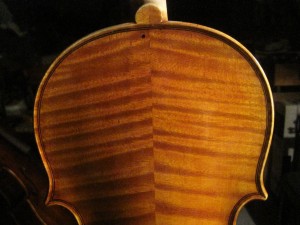 . This violin has everything that I find is so special about Italian violinmaking- (and its even magically present in a maker that you don’t know)- You feel the human hand, the beating heart and that artistic leap where spirit animates the labored object.
. This violin has everything that I find is so special about Italian violinmaking- (and its even magically present in a maker that you don’t know)- You feel the human hand, the beating heart and that artistic leap where spirit animates the labored object.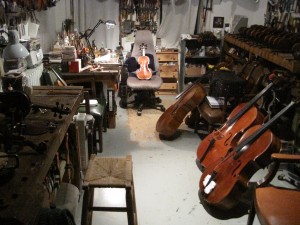 Finally, a shot of it surrounded by so many other inspiring instruments – I’m truly a lucky man to be immersed, through my late nights, with such things
Finally, a shot of it surrounded by so many other inspiring instruments – I’m truly a lucky man to be immersed, through my late nights, with such things
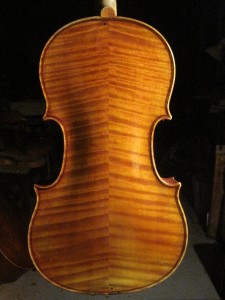
A beautiful,rugged viola by C.A Testore 1756
This great viola is part of the world famous string sound of the Philadelphia Orchestra. It made the arduous trek with the Orchestra on their recent tour in China and the far east and now needs some careful gluings ,varnish attention and a thorough going over to make sure all is well. This instrument has all the charm and style you look for in Carlo’s work The distinctive small,meager turns of the scroll and the narrowing peg box give real personality.On the back Carlo dresses up the plain maple with hand painted flames and saves time in the making by scratching on the purfling and you can see the remains his brand which depict the initials C A T in an eagle design that was the pattern of the sign in front of his shop in Milan of the second half of the 18th century 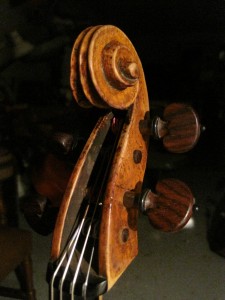 The bold, openly cut F-hole shows him working rather quickly and the photo hints at the strong,robust arching that gives this viola such power . Also evident is the tight grained spruce with the typical clear, yellowish varnish for which the Testore family are justly renowned for. Taken all together it is a wonderful example of bold instrument making, made efficiently for working musicians by artistic hands with personal and local style with ,above all , real life in its grain
The bold, openly cut F-hole shows him working rather quickly and the photo hints at the strong,robust arching that gives this viola such power . Also evident is the tight grained spruce with the typical clear, yellowish varnish for which the Testore family are justly renowned for. Taken all together it is a wonderful example of bold instrument making, made efficiently for working musicians by artistic hands with personal and local style with ,above all , real life in its grain
